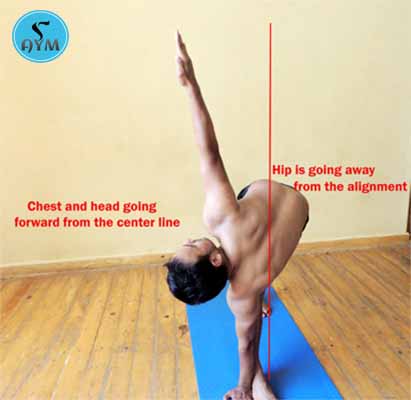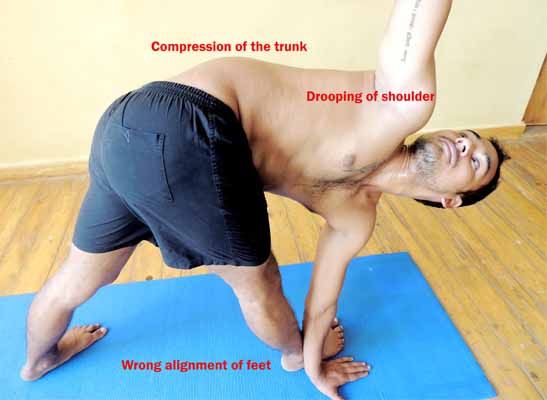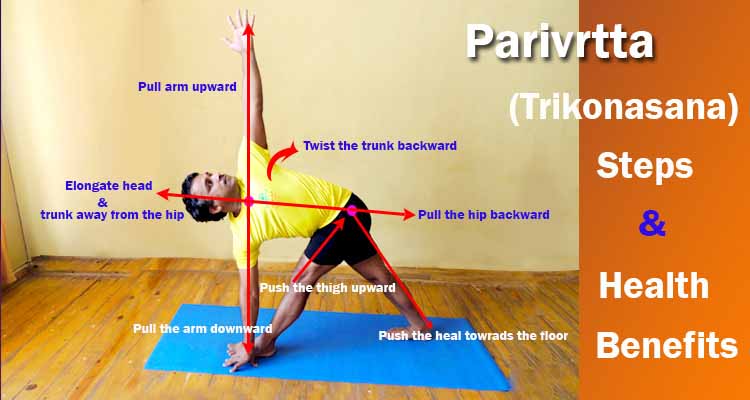
Parivrtta Trikonasana
Posted On : 26 November 2016.
Posted By :Yogi Mahesh Chetan.
Parivrtta Trikonasana
Word Meaning:Parivrtta =Parivrtta means revolved or twisted or turned..
Trikonasana =Tri means three and Kona means angles.
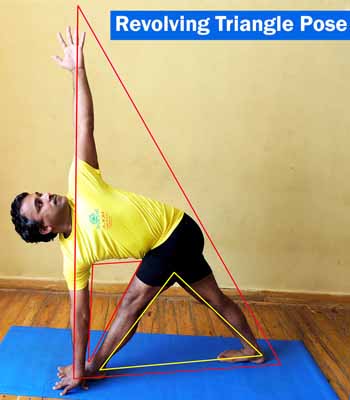
Detailed Method- How to get into Parivrtta Trikonasana
Feet & Legs
Take a gap between your feet around three and a half feet to four feet apart, as in Warrior I pose or Parsvottanasana also. Then turn your front right foot towards the right and left foot inwards. The position of both feet should not be in one line. Your front right foot should be in front of the right side, while your back should be behind your left thigh.
Rear Leg
Spread and widen the skin of both feet. Turning the back foot inwards depends on your left or rear foot's flexibility. If your rear foot is flexible enough, then push the rear foot into the floor while rotating the rear thigh inward. Also, press the outer edge of the rear foot and pull the inner edge of your rear foot upwards. In most of the standing poses, firmly engaging your back leg muscles to the bones and floor is essential. Draw your shinbone backward and engage your rear calf muscle to the shinbone. Straighten your knee by pressing the heel down and pulling the glutes muscles towards the hip. Push your rear femur inside your thigh bone and towards the back of the leg while rotating it slightly inwards. The rotation of the femur should be such that the front of your femur should face in front while lifting your groin upwards. Your rear leg should be similar to Adhomukha Svanasana or Parsvottanasana. The rear leg is the base for making balance in this pose. You will lose balance in this pose if your rear leg is unstable. So pushing your rear leg and activating back leg muscles is very important in this pose.
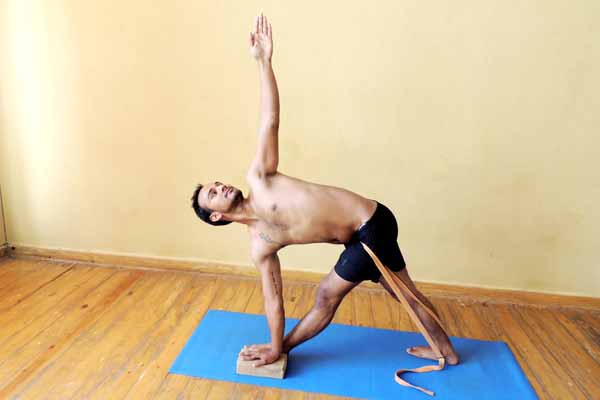
How to use strap to stop rear leg not to drop forward
Front Leg
Your forefoot should face in front of you and don’t let the weight of your body drop on it. Engage the calf muscles to your shinbone and straighten up your knee. Also, don’t let your thigh drop on your knee but you should strongly pull your thigh upward and backward. Pull the glutes muscles of your foreleg towards the ceiling. The position of your front thigh should be centralized, and your leg should not turn sidewards. Draw the shinbone of your front leg backward and engage your calf muscle to it.
In this pose, your hips and pelvis should be at one level. Hip of any side should not go up or down, and the hips should be square. Neither hip should be allowed to go forward or backward. When you start bending forward for twisting, as also in parsvottanasana, there is a tendency that your rear hip remains backward, so you have to strongly rotate it forward to bring it in line with the front hip. While your front hip is slightly turning backward, such that it is at level with the movement of the rear hip.
After aligning your hip and legs, you should start bending forward for twisting. Do not let your belly come out forward but you should apply Uddyanabandha in your abdomen. It will help you in keeping your backbone straight throughout this pose. Start bending forward, also start twisting your torso in such a way that both your shoulders are in one line with your front leg. Your backbone should be straight, and it should be in line with your front leg. To straighten your back more, strongly pull your hip backward and push your head and ribcage forward while having twisting action in your backbone. The twisting of your chest should be in such a way that your underside ribs should be below your upper side ribs. Keep turning your upper ribs backward and lower ribs forward to bring them in one axis.
Activate your upper front thigh upward and backward to elongate your chest and spine further. It will be good to have more distance between your head and front thigh and front hip. Also, try to pull your groin area backward.
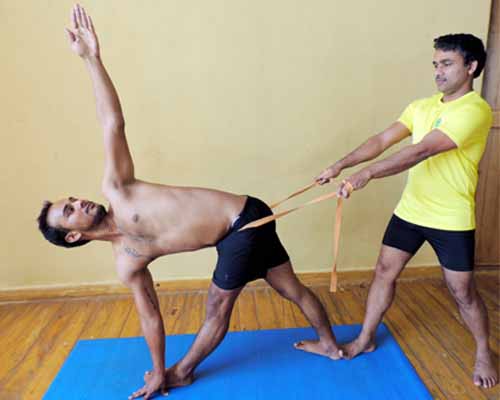
How to use strap to elongate trunk or spin.
In the final pose, your hand should be placed outside your front foot, but if flexibility limits you then you can place your hand inside of your front foot. Try to elongate both the arms away from each other while broadening your shoulder and pressing the shoulder blades into your upper back, and opening up your chest. Particularly use your upper arm more in this action.
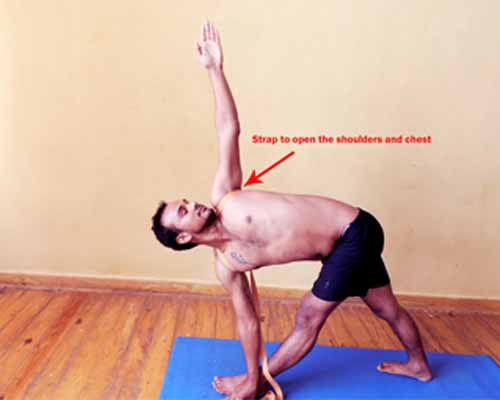
How to use strap to open the chest in revolving triangle pose
Keep your head in natural position if you are a beginner or are having neck pain. In the final pose, try to elongate the back of your neck, bringing your chin slightly inside in your neck which we say Chin-lock or Jalandhar bandha while turning your head to gaze upward at the top of the thumb.
In the case of Diarrhea, pregnancy, a heart patient, high or low blood pressure and severe back pain avoid doing this pose.
- As this pose is a balancing and active pose, it increases concentration and focuses power of the brain. It removes laziness and lethargicness from body and mind.
- As this pose is also a twisting pose, it brings very good effect on our internal organs such as intestine, liver, pancreas, kidneys, etc. The twisting action of this pose increases blood circulation in all body organs and brings more freshness and life to these organs.
- It is a very good posture for removing constipation and improving digestion power of the digestive system. It improves hunger and digestive fire.
- It is also a strengthening and stretching pose. It strengthens leg muscles and stretches back and internal organs.
- Effect on the nervous system- It is very good to activate the functioning of nerves by twisting action of the spinal column. It increases blood circulation in the central nervous system, which brings freshness and activation to the nervous system.
- Effect on respiratory system- This pose increases the flexibility of the chest and also broadens it, which in-turn increases lung capacity to get more fresh air. This further helps in improving freshness and relaxation.
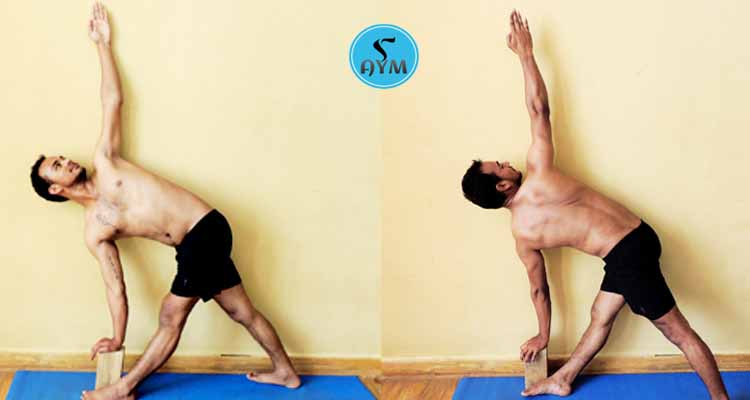
Trikonasana with Wall
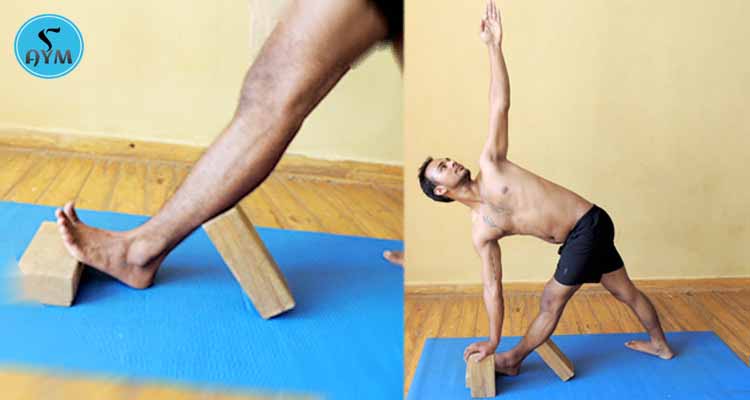
Trikonasana with Block
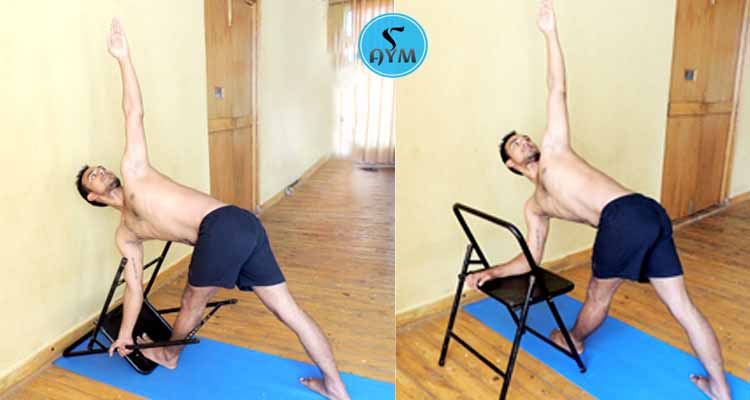
Trikonasana with Chair
